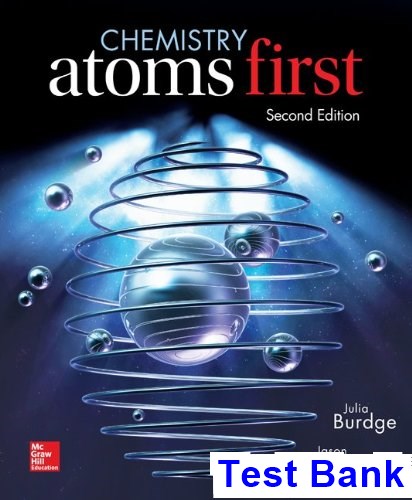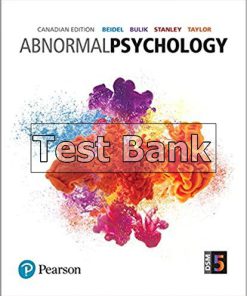Chemistry Atoms First 2nd Edition Burdge Test Bank
You may also like
Chemistry Atoms First 2nd Edition Burdge Test Bank

Product details:
- ISBN-10 : 0073511188
- ISBN-13 : 978-0073511184
- Author:
The Atoms First approach provides a consistent and logical method for teaching general chemistry. This approach starts with the fundamental building block of matter, the atom, and uses it as the stepping stone to understanding more complex chemistry topics. Once mastery of the nature of atoms and electrons is achieved, the formation and properties of compounds are developed. Only after the study of matter and the atom will students have sufficient background to fully engage in topics such as stoichiometry, kinetics, equilibrium, and thermodynamics. Thus, the Atoms First method empowers instructors to present the most complete and compelling story of general chemistry. Far from a simple re-ordering of topics, this is a book that will truly meet the needs of the growing atoms-first market.
Table contents:
- Chapter T: WebAssign Answer Templates and Tutorials
- T: WebAssign Answer Templates and Tutorials (4)
- Chapter 1: Essential Ideas
- 1.1: Chemistry in Context (9)
- 1.2: Phases and Classification of Matter (26)
- 1.3: Physical and Chemical Properties (20)
- 1.4: Measurements (20)
- 1.5: Measurement Uncertainty, Accuracy, and Precision (41)
- 1.6: Mathematical Treatment of Measurement Results (79)
- Chapter 2: Atoms, Molecules, and Ions
- 2.1: Early Ideas in Atomic Theory (14)
- 2.2: Evolution of Atomic Theory (5)
- 2.3: Atomic Structure and Symbolism (42)
- 2.4: Chemical Formulas (50)
- Chapter 3: Electronic Structure and Periodic Properties of Elements
- 3.1: Electromagnetic Energy (67)
- 3.2: The Bohr Model (21)
- 3.3: Development of Quantum Theory (27)
- 3.4: Electronic Structure of Atoms (Electronic Configurations) (117)
- 3.5: Periodic Variations in Element Properties (94)
- 3.6: The Periodic Table (18)
- 3.7: Molecular and Ionic Compounds (32)
- Chapter 4: Chemical Bonding and Molecular Geometry
- 4.1: Ionic Bonding (10)
- 4.2: Covalent Bonding (48)
- 4.3: Chemical Nomenclature (37)
- 4.4: Lewis Symbols and Structures (75)
- 4.5: Formal Charges and Resonance (37)
- 4.6: Molecular Structure and Polarity (73)
- Chapter 5: Advanced Theories of Bonding
- 5.1: Valence Bond Theory (9)
- 5.2: Hybrid Atomic Orbitals (32)
- 5.3: Multiple Bonds (26)
- 5.4: Molecular Orbital Theory (81)
- Chapter 6: Composition of Substances and Solutions
- 6.1: Formula Mass (42)
- 6.2: Determining Empirical and Molecular Formulas (52)
- 6.3: Molarity (35)
- 6.4: Other Units for Solution Concentrations (24)
- Chapter 7: Stoichiometry of Chemical Reactions
- 7.1: Writing and Balancing Chemical Equations (63)
- 7.2: Classifying Chemical Reactions (128)
- 7.3: Reaction Stoichiometry (34)
- 7.4: Reaction Yields (54)
- 7.5: Quantitative Chemical Analysis (22)
- Chapter 8: Gases
- 8.1: Gas Pressure (24)
- 8.2: Relating Pressure, Volume, Amount, and Temperature: The Ideal Gas Law (53)
- 8.3: Stoichiometry of Gaseous Substances, Mixtures, and Reactions (66)
- 8.4: Effusion and Diffusion of Gases (15)
- 8.5: The Kinetic-Molecular Theory (24)
- 8.6: Non-Ideal Gas Behavior (18)
- Chapter 9: Thermochemistry
- 9.1: Energy Basics (53)
- 9.2: Calorimetry (39)
- 9.3: Enthalpy (113)
- 9.4: Strengths of Ionic and Covalent Bonds (39)
- Chapter 10: Liquids and Solids
- 10.1: Intermolecular Forces (51)
- 10.2: Properties of Liquids (22)
- 10.3: Phase Transitions (37)
- 10.4: Phase Diagrams (32)
- 10.5: The Solid State of Matter (24)
- 10.6: Lattice Structures in Crystalline Solids (42)
- Chapter 11: Solutions and Colloids
- 11.1: The Dissolution Process (15)
- 11.2: Electrolytes (20)
- 11.3: Solubility (14)
- 11.4: Colligative Properties (90)
- 11.5: Colloids (15)
- Chapter 12: Thermodynamics
- 12.1: Spontaneity (13)
- 12.2: Entropy (42)
- 12.3: The Second and Third Law of Thermodynamics (31)
- 12.4: Free Energy (35)
- Chapter 13: Fundamental Equilibrium Concepts
- 13.1: Chemical Equilibria (2)
- 13.2: Equilibrium Constants (100)
- 13.3: Shifting Equilibria: Le Châtelier’s Principle (31)
- 13.4: Equilibrium Calculations (56)
- Chapter 14: Acid-Base Equilibria
- 14.1: Brønsted-Lowry Acids and Bases (64)
- 14.2: pH and pOH (55)
- 14.3: Relative Strengths of Acids and Bases (106)
- 14.4: Hydrolysis of Salt Solutions (20)
- 14.5: Polyprotic Acids (5)
- 14.6: Buffers (41)
- 14.7: Acid-Base Titrations (49)
- Chapter 15: Equilibria of Other Reaction Classes
- 15.1: Precipitation and Dissolution (90)
- 15.2: Lewis Acids and Bases (25)
- 15.3: Multiple Equilibria (20)
- Chapter 16: Electrochemistry
- 16.1: Review of Redox Chemistry (7)
- 16.2: Galvanic Cells (47)
- 16.3: Electrode and Cell Potentials (38)
- 16.4: Potential, Free Energy, and Equilibrium (37)
- 16.5: Batteries and Fuel Cells (12)
- 16.6: Corrosion (9)
- 16.7: Electrolysis (21)
- Chapter 17: Kinetics
- 17.1: Chemical Reaction Rates (35)
- 17.2: Factors Affecting Reaction Rates (11)
- 17.3: Rate Laws (67)
- 17.4: Integrated Rate Laws (40)
- 17.5: Collision Theory (47)
- 17.6: Reaction Mechanisms (31)
- 17.7: Catalysis (29)
- Chapter 18: Representative Metals, Metalloids, and Nonmetals
- 18.1: Periodicity (27)
- 18.2: Occurrence and Preparation of the Representative Metals (5)
- 18.3: Structure and General Properties of the Metalloids (3)
- 18.4: Structure and General Properties of the Nonmetals (2)
- 18.5: Occurrence, Preparation, and Compounds of Hydrogen (3)
- 18.6: Occurrence, Preparation, and Properties of Carbonates (2)
- 18.7: Occurrence, Preparation, and Properties of Nitrogen (3)
- 18.8: Occurrence, Preparation, and Properties of Phosphorus (5)
- 18.9: Occurrence, Preparation, and Compounds of Oxygen (3)
- 18.10: Occurrence, Preparation, and Properties of Sulfur (3)
- 18.11: Occurrence, Preparation, and Properties of Halogens (3)
- 18.12: Occurrence, Preparation, and Properties of the Noble Gases (4)
- Chapter 19: Transition Metals and Coordination Chemistry
- 19.1: Occurrence, Preparation, and Properties of Transition Metals and Their Compounds (9)
- 19.2: Coordination Chemistry of Transition Metals (4)
- 19.3: Spectroscopic and Magnetic Properties of Coordination Compounds (4)
- Chapter 20: Nuclear Chemistry
- 20.1: Nuclear Structure and Stability (33)
- 20.2: Nuclear Equations (13)
- 20.3: Radioactive Decay (51)
- 20.4: Transmutation and Nuclear Energy (20)
- 20.5: Uses of Radioisotopes (6)
- 20.6: Biological Effects of Radiation (11)
- Chapter 21: Organic Chemistry
- 21.1: Hydrocarbons (63)
- 21.2: Alcohols and Ethers (20)
- 21.3: Aldehydes, Ketones, Carboxylic Acids, and Esters (36)
- 21.4: Amines and Amides (22)
People also search:
chemistry atoms first 2nd edition
mcmurry and fay general chemistry atoms first 2nd edition
introductory chemistry an atoms first approach 2nd edition
chemistry an atoms first approach 2nd edition
chemistry atoms first 2e answers












